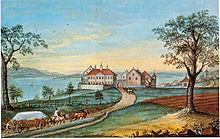Kirchberg Castle (Immenstaad on Lake Constance)
Kirchberg Castle is a facility in the municipality of Immenstaad on Lake Constance . For most of its history, the property served the Salem monastery as an estate and its abbots as a secondary residence.
history
In the place of today's building complex there was probably a fortified homestead of Count Otto and Hartmann von Kirchberg with a chapel that gave it its name. In 1288 the property and the surrounding fields came into the possession of the Cistercian monastery of Salem via the Kempten monastery , which was only briefly owner of the property , which let lay brothers manage the property . The main product was wine , which is still grown today on the surrounding land.
The palace complex remained with the Salem Monastery until the secularization of 1802, whose abbots used it as a secondary residence and made various structural changes. Like Salem, the castle became the property of the Margrave of Baden . This continued to use the property for viticulture.
During the Second World War, departments of the aircraft manufacturer Dornier were temporarily housed in the buildings . After the end of the war, around 50 German and 40 Italian diplomats were interned in Kirchberg Castle by the French occupation troops who were suspected of having been involved in war crimes , such as Konstantin von Neurath , Reich Foreign Minister from 1932 to 1938. Later, the Salem Castle School in Kirchberg set up a branch. Then Dornier returned again. In 1995 the house in Baden sold Kirchberg Castle. After extensive renovation around the year 2000, the buildings are now condominiums.
investment
The castle is worth seeing just because of its location in the middle of the vineyards, 25 meters above Lake Constance and with a view over the same. The building complex consists of various buildings that were created in different construction phases.
chapel
The chapel represents the nucleus of the property, but no longer exists in its early medieval form, as it was rebuilt according to the respective new requirements. In 1501 the existing medieval chapel had to give way to a new building with three altars, which was redesigned in the Baroque style by Joseph Anton Feuchtmayer from 1739 to 1742 . The old church building was torn down in favor of a house chapel in the 19th century.
Old castle / south wing
From 1546 to 1549 a new three-storey building resembling a castle, the so-called Old Castle , was built, and an existing medieval residential tower may have been incorporated into the building.
The facade and interior have been changed several times over the course of history, most recently in 1880 and 1890 for the purpose of aligning with the east wing.
East wing
The east wing represents the youngest part of the palace buildings and was built from 1755 to 1775 by the Salem architect Johann Joachim Scholl. Johann Georg Dirr , who among other things stuccoed the magnificent abbot's apartment , was also involved in the furnishing . However, this work was lost in the redesign.
Here, too, the exterior and interior were redesigned in the 19th century.
Hofmeister building
The Hofmeister building originally dates from 1604, but was rebuilt in the first half of the 18th century. It served as a residence for economic officials of the monastery.
Farm buildings
The simple farm buildings also included a torkel , indispensable for wine production. The construction took place around the same time as the baroque style of the chapel.
literature
- Michael Losse (Ed.): Castles, palaces, aristocratic residences and fortifications on Lake Constance and the Upper Rhine, Volume 1.2: Eastern part around Meersburg, Immenstaad, Friedrichshafen, Bermatingen, Markdorf and Deggenhausertal . Michael Imhof Verlag, Petersberg 2013, ISBN 978-3-86568-812-5 , pp. 60-65.
- Günter Schmitt : Palaces and fortresses on Lake Constance. Volume II - North-East . Biberacher Verlagsdruckerei, Biberach 2001, ISBN 3-933614-09-0 , pp. 72-93.
- Harald Derschka : Kirchberg Castle . In: Eveline Schulz, Elmar L. Kuhn , Wolfgang Trogus (ed. On behalf of the Immenstaad municipality): Immenstaad. History of a Seegemeinde , Stadler Verlagsgesellschaft, Konstanz 1995, ISBN 3-7977-0313-9 , pp. 415-428.
Web links
Individual evidence
- ↑ Harald Derschka: Kirchberg Castle. In: Immenstaad. History of a maritime community. Editors: Eveline Schulz, Elmar L. Kuhn, Wolfgang Trogus on behalf of the Immenstaad municipality, Stadler Verlagsgesellschaft, Konstanz 1995. ISBN 3-7977-0313-9 , page 426.
Coordinates: 47 ° 40 ′ 4.3 " N , 9 ° 20 ′ 20.3" E





